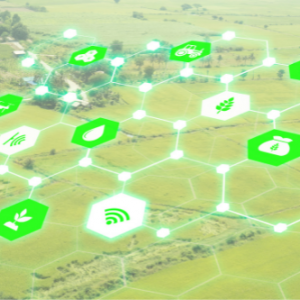A smart factory is a highly digitized and connected production facility, enabled by IoT connected devices. The term Internet of Things generally refers to scenarios where network connectivity and computing capability extends to objects, sensors and everyday items not normally considered computers. This allows these devices to generate, exchange and consume data with minimal human intervention. Alongside big data, data analytics, robotics, machine learning, sensor technologies and artificial intelligence, these technologies are used together to optimise manufacturing processes and keep workers safe.
Implementing IoT in a production line context is a route to digital transformation in manufacturing. By employing a network of sensors to collect critical production data and cloud software to turn this data into valuable insights about the efficiency of the manufacturing operations, production facilities can transform into digitally-driven smart factories. With this intelligence, manufacturers can deliver quality products to the consumer while maximising efficiency and profit.
Table of Contents
The essential components for IoT in manufacturing and smart factory
For decades now, Machine-to-Machine (M2M) technologies have enabled communication across the shop floor. Now, with the full integration of M2M and Machine-to-Human (M2H) technologies signalling the dawn of the Internet of Things (IoT), we are witnessing unprecedented transparency across production lines. Today, real-time visualisation of internal processes enables facility managers to make decisions faster — and smarter.
These connected devices keep managers up-to-date on their performance, allowing them to streamline operations, identify inefficiencies, and improve productivity. The real-time visibility also translates into enhanced safety through instant alerting and notifying the relevant staff members or workers at risk. To go smart, a factory needs to include the following key components:
- Sensors: Sensors are basically the driving force behind an IoT ecosystem in manufacturing. They consolidate data in real-time with the ability to integrate with direct database systems, legacy ERP systems or data warehouses.
- Network connectivity: Recently, Internet connectivity has become increasingly reliable and affordable, allowing manufacturers to deploy facility-wide networks. Existing standards such as Bluetooth, WiFi, BLE, RFID, ZigBee, Z-wave and IPv6 are now widely used in IoT-enabled factories.
- IoT Platform: An IoT platform connects access points and data networks to end-user applications, which allows companies to automate their processes and analyze data. In other words, IoT platforms act as middleware solutions that connect the data collected at the edge and the user-facing SaaS or mobile app.
Thus, an IoT system comprises a chain of the following processes and components:
A communication network to transmit data throughout the system
Sensors and controllers
↓
A gateway device to collect data and send them back to the server
↓
Data analytics and data visualization software
↓
A user-facing application
Adoption drivers and key benefits for a smart factory
Economy
Certainly, implementing smart technologies requires an initial investment; however, one of the key adoption drivers is cost. Sensors, real-time analysis and alerts optimise asset and inventory management, reduce machine downtime, cut energy usage and create a more agile production line. As such, this increased agility can substantially reduce operating costs, which more than accounts for the initial expense.
Equipment optimisation
Sensors can also track various assets (machinery, equipment, tools, trucks, etc.) in real-time, providing visibility of their potential. On the basis of this data, businesses can make quick decisions and optimise their asset usage. Furthermore, suppliers and OEMs can also benefit from real-time parameter monitoring and logging. With this information, they can identify whether repairs or part replacements are covered by a warranty, providing a complete and reliable picture of the equipment operating conditions.
Efficiency and quality
This increase in efficiency can also dramatically reduce product cycle time. As the supply chain is more efficient, time-to-market is significantly cut. Moreover, as production lines become more complex, IoT technology can align units to facilitate mass customisation. For instance, mass customisation processes require a dramatic increase in the variety of produced SKUs (stock keeping unit), which causes inventory to increase and diversify. To manage this reality, IoT can provide a source of real-time data required for thoughtful forecasting, shop floor scheduling and routing. Furthermore, automation eliminates human error, enabling a higher standard of production across the board.
Productivity and safety
Finally, the smart factory has several benefits for employees. Namely, it can improve productivity, as real-time data allows employees to monitor and improve processes efficiently without delays. However, the benefits of IoT aren’t only economic; IoT helps to ensure a safer workplace. Paired with wearable devices, IoT allows monitoring workers’ health state and risky activities that can lead to injuries. Along with ensuring workers’ safety, IoT addresses safety problems in potentially hazardous environments.
The smart factory is transforming manufacturing
The Internet of Things is revolutionising the manufacturing sector, paving the way for a new type of industry. From the smart factory to connected supply chains, enterprises are leveraging IoT development to streamline automation, boost productivity and optimise operations. As the digitisation trend unfolds, early adopters have a better chance to maximise benefits and maintain a competitive edge. As such, implementing a plan for digitisation is crucial to staying ahead of the game. By creating a plan for IoT implementation now, manufacturers can begin to reap the rewards of increased efficiency, reduced costs and enhanced employee productivity that the smart factory brings as soon as possible.
Outvise is a unique global talent network with a focus on Business Tech. We are helping our clients to run with their new projects and digital transformation needs with a specific focus on the Telecom and Media space. We have already provided thousands of days worth of highly specialised expertise for industry-leading companies and management consulting firms across more than 20 countries.






No comments yet
There are no comments on this post yet.